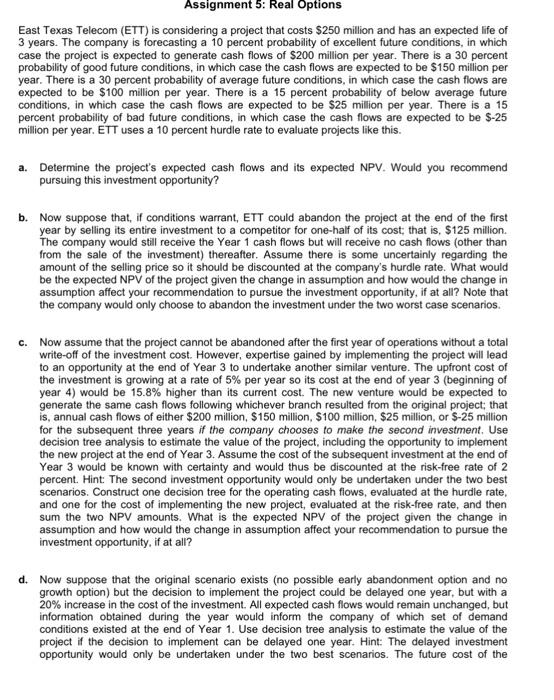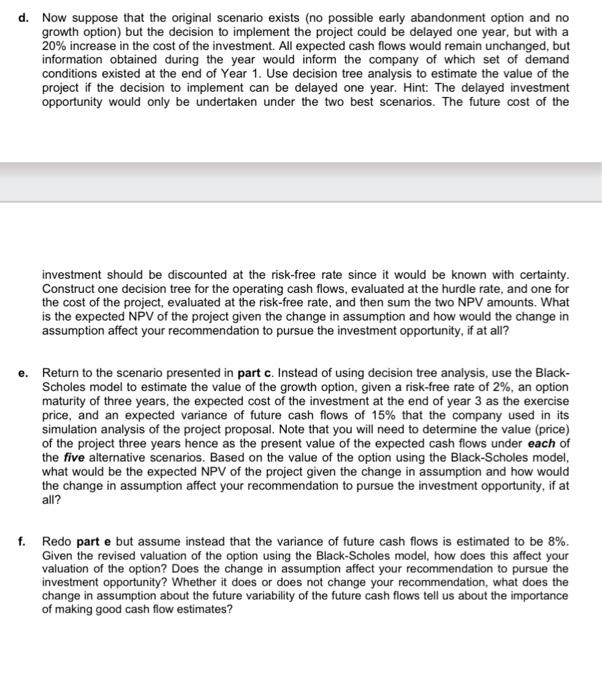Six part question over Real Options. Please show work/excel calculations.

Assignment 5: Real Options East Texas Telecom (ETT) is considering a project that costs $250 million and has an expected life of 3 years. The company is forecasting a 10 percent probability of excellent future conditions, in which case the project is expected to generate cash flows of $200 million per year. There is a 30 percent probability of good future conditions, in which case the cash flows are expected to be $150 million per year. There is a 30 percent probability of average future conditions, in which case the cash flows are expected to be $100 million per year. There is a 15 percent probability of below average future conditions, in which case the cash flows are expected to be \$25 million per year. There is a 15 percent probability of bad future conditions, in which case the cash flows are expected to be $25 million per year. ETT uses a 10 percent hurdle rate to evaluate projects like this. a. Determine the project's expected cash flows and its expected NPV. Would you recommend pursuing this investment opportunity? b. Now suppose that, if conditions warrant, ETT could abandon the project at the end of the first year by selling its entire investment to a competitor for one-half of its cost; that is, \$125 million. The company would still receive the Year 1 cash flows but will receive no cash flows (other than from the sale of the investment) thereafter. Assume there is some uncertainly regarding the amount of the selling price so it should be discounted at the company's hurdle rate. What would be the expected NPV of the project given the change in assumption and how would the change in assumption affect your recommendation to pursue the investment opportunity, if at all? Note that the company would only choose to abandon the investment under the two worst case scenarios. c. Now assume that the project cannot be abandoned after the first year of operations without a total write-off of the investment cost. However, expertise gained by implementing the project will lead to an opportunity at the end of Year 3 to undertake another similar venture. The upfront cost of the investment is growing at a rate of 5% per year so its cost at the end of year 3 (beginning of year 4 ) would be 15.8% higher than its current cost. The new venture would be expected to generate the same cash flows following whichever branch resulted from the original project; that is, annual cash flows of either \$200 million, \$150 million, \$100 million, \$25 million, or \$-25 million for the subsequent three years if the company chooses to make the second investment. Use decision tree analysis to estimate the value of the project, including the opportunity to implement the new project at the end of Year 3. Assume the cost of the subsequent investment at the end of Year 3 would be known with certainty and would thus be discounted at the risk-free rate of 2 percent. Hint: The second investment opportunity would only be undertaken under the two best scenarios. Construct one decision tree for the operating cash flows, evaluated at the hurdle rate, and one for the cost of implementing the new project, evaluated at the risk-free rate, and then sum the two NPV amounts. What is the expected NPV of the project given the change in assumption and how would the change in assumption affect your recommendation to pursue the investment opportunity, if at all? d. Now suppose that the original scenario exists (no possible early abandonment option and no growth option) but the decision to implement the project could be delayed one year, but with a 20% increase in the cost of the investment. All expected cash flows would remain unchanged, but information obtained during the year would inform the company of which set of demand conditions existed at the end of Year 1. Use decision tree analysis to estimate the value of the project if the decision to implement can be delayed one year. Hint: The delayed investment opportunity would only be undertaken under the two best scenarios. The future cost of the d. Now suppose that the original scenario exists (no possible early abandonment option and no growth option) but the decision to implement the project could be delayed one year, but with a 20% increase in the cost of the investment. All expected cash flows would remain unchanged, but information obtained during the year would inform the company of which set of demand conditions existed at the end of Year 1. Use decision tree analysis to estimate the value of the project if the decision to implement can be delayed one year. Hint: The delayed investment opportunity would only be undertaken under the two best scenarios. The future cost of the investment should be discounted at the risk-free rate since it would be known with certainty. Construct one decision tree for the operating cash flows, evaluated at the hurdle rate, and one for the cost of the project, evaluated at the risk-free rate, and then sum the two NPV amounts. What is the expected NPV of the project given the change in assumption and how would the change in assumption affect your recommendation to pursue the investment opportunity, if at all? e. Return to the scenario presented in part c. Instead of using decision tree analysis, use the BlackScholes model to estimate the value of the growth option, given a risk-free rate of 2%, an option maturity of three years, the expected cost of the investment at the end of year 3 as the exercise price, and an expected variance of future cash flows of 15% that the company used in its simulation analysis of the project proposal. Note that you will need to determine the value (price) of the project three years hence as the present value of the expected cash flows under each of the five alternative scenarios. Based on the value of the option using the Black-Scholes model, what would be the expected NPV of the project given the change in assumption and how would the change in assumption affect your recommendation to pursue the investment opportunity, if at all? f. Redo part e but assume instead that the variance of future cash flows is estimated to be 8%. Given the revised valuation of the option using the Black-Scholes model, how does this affect your valuation of the option? Does the change in assumption affect your recommendation to pursue the investment opportunity? Whether it does or does not change your recommendation, what does the change in assumption about the future variability of the future cash flows tell us about the importance of making good cash flow estimates









